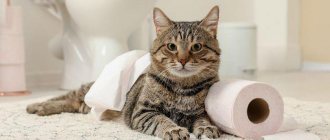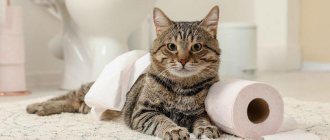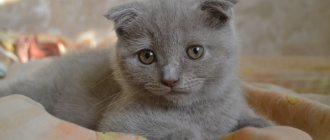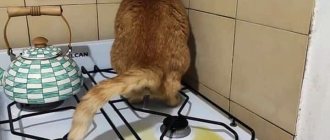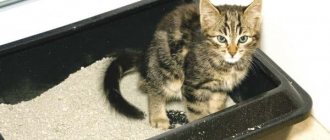A cat is without a doubt the cutest and friendliest pet. Cuddling and playing with your cat are some of the fun activities that cat owners enjoy. However, problems arise when a domestic cat starts peeing all over the place rather than in a specific place.
The urine of a cat or any other animal obviously has a very unpleasant and pungent odor due to the cat's protein metabolism. The excretory product includes a mixture of phosphates, uric acid and aerates. When your cat suffers from an infection or inflammation in the urinary tract, the concentration of protein may be significantly higher and she may smell worse. As urine dries, it forms crystals that form stains that are very difficult to remove.
How often do cats go to the toilet?
When a cat goes to the toilet a little at a time, this in most cases indicates pathology.
The norm for visiting the litter box is determined by the age of the pet. Up to 3 months, a cat pees once a day. This is a norm associated with the characteristics of metabolic processes.
From 3 months, visiting the tray is required 2 times a day. Starting from 4 months, young and adult cats urinate 3 times, and males urinate 4 times a day.
Castrated and sterilized cats have a greater need to visit the litter box.
It is normal for them to urinate up to 5 times a day. When feeding animals dry food, the volume of urine decreases. In hot weather, when pets drink more water due to overheating, visiting the litter box up to 7 times a day can be the norm.
Behavior correction
If, after cleaning the “puddle,” the cloth lies in the baby’s tray, then he will remember by the smell where to defecate.
If you have problems visiting the kitten's litter box, it is important for the owner to be patient and try to accustom the animal to the toilet. To do this, you need to monitor the baby, and wipe the place where he wrote with paper or cloth, and treat the surface with a chlorine-containing agent. Next, place the wet paper or cloth in the tray and let the kitten sniff. Next time the baby will look for a place to pee by smell, so until he has reliably relieved himself in his toilet, it is not recommended to regularly wash the litter box.
If an adult cat begins to pee wherever she wants, it will be much more difficult to wean her from this bad habit. Places where the animal has made puddles must be immediately cleaned and treated with chlorine-containing products; to be on the safe side, you can additionally use a special behavior correction spray. The next step is to change the tray. It is recommended to buy a comfortable, spacious toilet where the animal will feel comfortable. In addition to the hygiene item itself, it is recommended to choose a high-quality filler.
When cats urinate past the litter box out of spite, it is most likely due to stress. In this case, the correction methods proposed above will not be enough. First you need to eliminate the very cause of stress, and for this the owner will need patience and a lot of time. It is important to observe the cat and try to determine what is bothering and frightening it. In addition to observation, you should communicate and play with your pet, show affection and tenderness.
What to do when a disease is diagnosed?
If the animal is old and after castration, then it is better to show it to the doctor to check for the presence of ailments.
If an old or neutered cat starts peeing anywhere, you need to take your pet to the vet as soon as possible, because such behavior can be a symptom of urolithiasis, cystitis and other internal diseases. After determining the diagnosis, the doctor will prescribe a medical or surgical treatment regimen aimed at eliminating the primary source of urinary incontinence.
Reasons why pollakiuria may occur
The reasons why a cat begins to visit the toilet frequently, and urine output is insignificant, can be pathological and physiological. In the first case, the animal requires treatment, and in the second, the phenomenon is considered normal and should not cause concern.
If the owner cannot independently understand whether the animal is sick or not, consultation with a veterinarian is required, and urgently.
Many diseases of the bladder, kidneys, and metabolic diseases can be treated quite effectively, but if detected at an early stage. Some pathologies are chronic and the animal requires regular maintenance therapy.
What is cystitis and why does it appear?
The main reason for frequent visits to the toilet, when there is little urine left in the tray, and sometimes it is mixed with blood, is cystitis. This inflammatory disease of the bladder does not occur without provoking factors.
Be sure to read:
Black feces in a cat: normal or pathological, when is it a dangerous symptom, diagnosis, how to treat
Cystitis occurs as a primary pathology or complication. Depending on this, the necessary therapy is determined.
The development of cystitis in cats can be provoked by:
- disturbance of metabolic processes in the body (most often observed in old animals);
- suffered a severe infection;
- the presence of stones and sand in the kidneys, ureters or bladder;
- disturbance in mineral balance;
- improper nutrition, in which the cat does not receive enough proteins and fluids;
- infection of the genitourinary system;
- pregnancy and childbirth (cystitis can occur as a complication);
- cold.
Abdominal injuries can trigger the development of cystitis in a cat. This phenomenon is more typical of animals that have free access to the street, but can also be observed in apartment pets during unsuccessful jumps from a height.
The main reason for frequent visits to the toilet is when there is little urine left in the tray, and sometimes it is mixed with blood
With cystitis, a cat not only experiences frequent urination, but also meows when going to the toilet, as the process is accompanied by pain. Due to pain, the pet's behavior when trying to touch its stomach becomes aggressive.
Urolithiasis disease
Urolithiasis occurs in most older pets and some young ones. The risk of pathology in neutered cats that receive improper nutrition increases slightly. In this case, the owners themselves are to blame for the fact that the animal begins to get sick.
For neutered pets, you should use only special ready-made food or coordinate their natural diet with a veterinarian.
Stones not only injure the mucous membrane, causing irritation and inflammation, but also lead to blockage of the ureter, which impairs the flow of urine. If urine stagnation occurs and the cat does not receive emergency treatment, it dies within a few days.
The fact that an animal has urolithiasis can be guessed by its too frequent visits to the tray, during which urine is excreted in small quantities mixed with blood.
At the same time, the general condition of the animal worsens. A complete lack of urination is an emergency condition when you cannot postpone a visit to the veterinarian even for a day.
Urolithiasis develops slowly. First, sand deposition begins in the kidneys. It does not interfere with the flow of urine and rarely causes any symptoms. Remaining in the kidneys, sand becomes compacted over time, and stones begin to form.
Be sure to read:
Constipation in a cat: causes, first aid, home treatment, best remedies
Fractions increase gradually. Small in size, they pass through the ureters and are partially removed in the urine. If treatment is not started at this stage, the stones will enlarge and cause health problems for the pet.
If your cat goes to the toilet frequently due to diabetes
Cats with diabetes also experience increased urination . At the same time, the animal's thirst increases. The cat begins to drink excessive amounts of water and, as a result, the need to visit the litter box increases.
The kidneys suffer from high levels of glucose in the blood and cannot cope with the load. As a result, despite the increased urge, the volume of urine released decreases. Treatment of the animal requires comprehensive treatment.
The cat pees on the bed, the main reasons
Stress, strong emotional experience, disruption of the usual way of life - these are not all the reasons why a cat pisses on the bed and other places. Ignoring the litter tray by an animal may indicate the development of systemic diseases of the internal organs. It would be a good idea to show it to a veterinarian to rule out serious pathologies that could cost the pet’s life. Let's look at the main reasons why a cat pees on the bed, and then we'll figure out what to do about it and how to stop your pet from pooping in the wrong place.
Causes not related to illness
Diabetes mellitus in cats also causes increased urination.
Veterinarians also identify causes that are not related to the disease. With them, the cat does not require treatment. They are associated with temporary external influences or the physiological needs of the pet.
The general condition of the cat rarely suffers.
Stressful situation
Stress occurs in cats just as it does in humans. The phenomenon can be triggered by moving, the appearance of another animal or a new person in the house. In addition to frequent visits to the litter box, stress is indicated by a change in the cat’s behavior and an increase or decrease in appetite.
During periods of stress, cats experience a drop in immunity, resulting in a risk of developing cystitis. Thus, stress, which usually goes away on its own, can provoke an inflammatory process that requires treatment.
Because of this, if, due to stress, the cat’s urination becomes not only frequent, but also mixed with blood, a visit to the veterinarian is required.
Extreme thirst and drinking too much water
In the heat, the animal consumes a large amount of water, which leads to increased formation of urine and its frequent excretion. This process is natural and does not require treatment. As soon as the cat stops suffering from the heat and drinking excess water, frequent trips to the toilet will end.
If the air temperature is normal, and the pet suddenly starts drinking a lot of water, this is a sign of the development of pathology. When examined in such a situation, the cat may be diagnosed with diabetes, kidney pathologies, or cancerous tumors in the intestines. The necessary treatment will be determined by your veterinarian.
Be sure to read:
Urinary incontinence in a cat: causes and treatment, symptoms, medication and alternative treatment
Territory designation
Cats and some cats mark their territory with urine. They splash on different surfaces while standing, raising their tail and shaking it. The urine has a special pungent odor. It is impossible to confuse this action with a regular trip to the toilet.
Getting rid of stains and odor
How to remove odor and stains? They are eliminated using special products that are sold in pet stores or folk remedies. In this case, you will have to treat every area in the room. The process is quite labor intensive. To avoid a situation where a cat shits on the bed, it is necessary to wean the animal from a bad habit.
Folk remedies
It is difficult to remove stains and unpleasant odors from the bed. This is especially true for marks. Folk remedies used to get rid of odor:
- The aroma of citrus fruits repels cats, and the acid helps neutralize odors. To do this, squeeze lemon juice, dilute with a glass of boiled water, wipe the surfaces;
- Dilute vinegar removes stains and odors well;
- Baking soda with hydrogen peroxide 3% (suitable for hard surfaces only);
- Alcohol or vodka – thoroughly wipe the stained area with a sponge soaked in vodka or alcohol;
- Potassium permanganate - will eliminate odor, but is only suitable for dark-colored fabrics, not delicate ones.
Under no circumstances should you use bleach to eliminate odors. The product will worsen the situation and may act as a sleeping pill on cats.
Lemon juice
Vinegar
Baking soda and hydrogen peroxide
Alcohol
Potassium permangantsovka
Radical methods
Radical methods are started when there is nothing else left. If the owner does not intend to breed cats, the best option would be castration for cats or sterilization for cats. The procedure should help, and the cat will stop marking the territory. It is important that the animal be neutered before it has contact with the cat. Otherwise, this radical method may not help. Males are usually neutered before the age of 1 year. After the procedure, it will take several more months before the animal stops marking. During this time, the body undergoes a restructuring.
Additional Tips
Let's summarize briefly. Be careful and watch your pet. If you suspect any abnormalities in his health, go straight to the veterinarian. Try to block the places your cat chooses to vent. Family bed? Close access to the bedroom, etc. Carefully clean the places where the animal “goes”: the smell of urine will attract it here again and again. The tray should always be clean; if possible, move it to the least crowded, secluded place in the apartment. Finally, just ask for advice from an experienced professional, preferably a veterinarian - there may be reasons we forgot to mention in this article.
Original publication: My Cat Started Peeing on My Bed & Clothes! Why? Author: Jay Matthews Source and photo:
The pet is overexcited
In case of excessive nervous overexcitation of the animal, you should pay close attention to its behavior. If a cat, for some unknown reason, is afraid of its owner or, on the contrary, shows aggression, behaves abnormally, runs chaotically around the apartment, this may be a serious problem with the pet’s nervous system or a sign of rabies. In this situation, the animal must be placed in a closed carrier, through which it cannot bite or scratch, and taken to a veterinarian.

